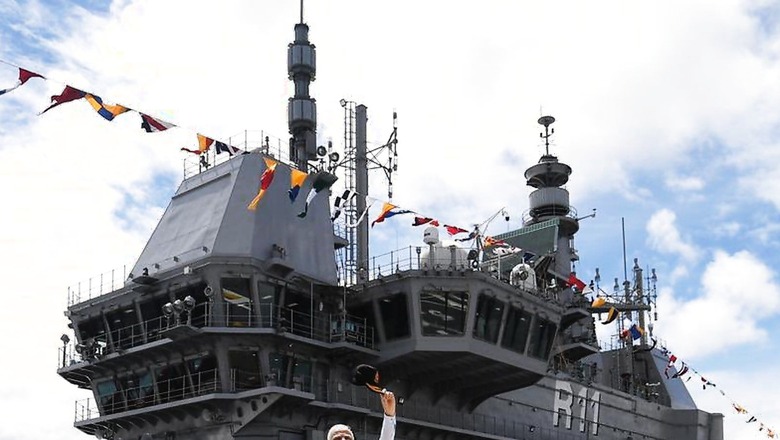
views
Prime Minister Narendra Modi commissioned and dedicated to the nation its first indigenously built 45,000 tonne aircraft carrier rechristened Vikrant. In the Navy, ships don’t fade away; they reincarnate. Therefore, this ship takes the name of its earlier avatar, Vikrant, India’s first aircraft carrier purchased from the UK in 1960.
The ship has been designed by the Warship Design Bureau of the Indian Navy and built by Cochin Shipyard Limited, a Ministry of Shipping & Ports shipbuilding yard. Over 75 per cent of the contents are homemade. A number of major builders, both in public and private sector such as BHEL, BEL, SAIL, L&T, MAHINDRAS, TATAS, etc, and hundreds of MSMs, joined hands for the biggest warship ever built in India.
Thus India joins the club of 6-7 countries that build aircraft carriers. It will be home to a combination of 30 aircraft, fighters, Ka 31, MH 60R and Advanced Light Helicopters. The total crew of 1,700 will be dispersed in some 2,700 compartments located in 14 decks. The 2,500-km plus cabling and power generation capable of lighting up the entire city of Kochi is an engineering marvel. The project management, automated construction, and modular design are propelled by four LM 2500 gas turbine engines. This aptly justifies this ship to be called a ‘Township’.
On the indigenisation front, it is a big leap. The Indian industry has pitched in to lend its shoulders, making the ship largely indigenous. The ship construction has led to approximately Rs 19,000 crore being ploughed back into India’s economy in the process of manufacturing thousands of components. The shipyard is confident of building heavier ships in future, both warships and merchant ships. There is a good scope of building containers and bulk carriers in the future. It is understood that a bigger dry dock/slipway is already under construction. This augurs well with the drive of India to become a $5 trillion economy in the near future. Merchant shipbuilding is an area which needs a big push for India to become a formidable maritime power. The Sagarmala project addresses many of these areas.
Though the ship construction slowed down due to inadequacy of funds at one time, the present government of Prime Minister Narendra Modi has provided much-needed push to defence preparedness of the country by funding a number of delayed projects, results of which are visible. His drive towards indigenous manufacturing of war-fighting platforms and equipment under ‘Aatmanirbhar Bharat’ has accelerated in the past five years. Therefore, his commissioning of the Vikrant is very significant for the country, the armed forces and him personally. The CCS has also approved development of next generation fighter aircraft in the country.
The expertise gained in building the aircraft carrier and employment generated in the process need to be sustained and a decision on building the second indigenous aircraft carrier IAC II needs to be taken soon. Similarly, indigenously built weapons and platforms, after meeting the commitments of the armed forces, could be exported to earn foreign exchange which could accelerate the economy.
A look at the geopolitical scenario in the world and closer home in the Indo-Pacific would be instructive to understand the relevance of India’s push for indigenisation and commissioning of Vikrant.
The rise of China, both economically and militarily, and its intimate collusion with our western neighbour, Pakistan, are two immediate concerns. Both these countries have adversarial relations due to land border disputes which seem unlikely to resolve anytime soon. China has armed Pakistan to the hilt. It is in the process of building and supplying eight submarines and 3-4 warships. Nuclear proliferation by China/North Korea has already made Pakistan a nuclear armed state.
Over the last decade, China has economically coerced India’s neighborhood and established its foot firmly by way of taking possession of ports, bases, airfields in swap for debt trap. All these assets are dual use, for economic and military purposes. Hambantota in Sri Lanka, Gwadar in Pakistan, Kyauk Phyu in Myanmar, islands in Maldives, impending foothold in Mauritius, Seychelles, Madagascar, countries in East coast of Africa are some examples in the IOR littorals which encircle India and shrink the maneuvering space for the Indian Navy.
Under the pretext of anti-piracy operations, Chinese ships and submarines are omnipresent in the Indian Ocean with a full-fledged base in Djibouti in the Gulf of Aden. These are the challenges of India in its area of operations through which it traverses important sea lanes of communication and trade.
The continuing drug and human smuggling, piracy, terrorism, natural and man-made disasters, illegal unreported fishing, etc are other non-traditional threats which exist in the IOR. At any given time IOR witnesses warships of approximately 34 countries and annual transit of nearly 1,30000 merchant ships which directly criss-cross India’s own trade routes.
With the comprehensive national power gap between the US and China reducing and China overtaking the US economy in all likelihood, it has been observed that the Chinese attitude has become aggressive and non-compromising. Its outrageous display of military power around Taiwan and its coercion in the Pacific in recent times are only continuum of China’s aggressive behaviour. It has already built three aircraft carriers and hypersonic missiles. The recent Russia-Ukraine conflict and China’s alliance with Russia is probably adding to its belligerent behaviour. The unipolarity of the US seems to be headed for collapse, as such China sees itself in dividing the world into bipolarity which could force smaller nations to choose sides.
In this scenario of changing world order, more disorder is likely to ensue. It is important for India to protect its economic interests staying clear of the contestation. And this is possible by not only strengthening the economy but also its hard power, particularly in the Indo-Pacific where the prosperity of citizens lies.
It is in the context of making India a strong military power which is needed not only for protecting its own economic and security interests but also those in the IOR littorals. Vikrant is one such important addition to the Navy’s armour which will help India maintain peace and stability in the region and beyond. India’s existing adverse trade balance calls for increased manufacturing and export and therefore its security. It also deters the adversaries in the Indo-Pacific from interfering with the region’s aspirations.
Read all the Latest Opinion News and Breaking News here




















Comments
0 comment